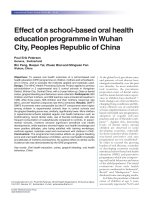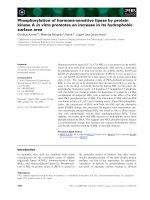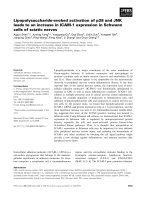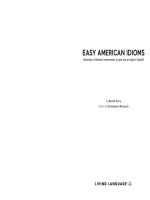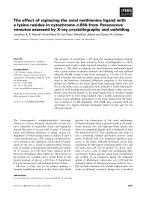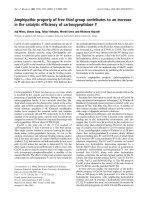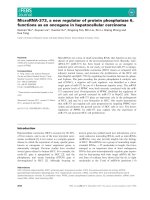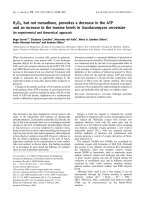Effect of blending of fats and oils on physico-chemical properties of Ghee
Bạn đang xem bản rút gọn của tài liệu. Xem và tải ngay bản đầy đủ của tài liệu tại đây (185.02 KB, 6 trang )
Int.J.Curr.Microbiol.App.Sci (2020) 9(8): 1127-1132
International Journal of Current Microbiology and Applied Sciences
ISSN: 2319-7706 Volume 9 Number 8 (2020)
Journal homepage:
Original Research Article
/>
Effect of Blending of Fats and Oils on Physico-chemical Properties of Ghee
Niranjan, G. Poojitha*, C. Kempanna and B. G. Shilpashri
Dairy Chemistry Division, Dairy Science College, KVAFSU,
Hebbal, Bangalore 560024, India
*Corresponding author
ABSTRACT
Keywords
Physico-chemical
properties, Ghee,
Fats and oils, Level
of blending
Article Info
Accepted:
10 July 2020
Available Online:
10 August 2020
The changes in the ghee physico-chemical properties due to blending with different
fats and oils at different levels were studied. Ghee was blended with Groundnut oil,
Coconut oil, Hydrogenated fat and animal body fat at 10% and 15% respectively. The
blended ghee samples were analysed for Reichert–Meissl, Polenske, saponification,
iodine values and butyro refractometer reading at 40°C. The study revealed that an
increase in B.R. reading and Iodine value are due to blending with groundnut oil and
hydrogenated fat, also an increase in the polenske and saponification values are due to
blending with coconut oil where as decrease in the B.R. reading and Iodine value are
due to blending with coconut oil and decrease in the Reichert–Meissl, Polenske,
saponification values are due to blending with hydrogenated fat and animal body fat at
10 & 15 per cent respectively.
Introduction
Ghee is well known for characteristic flavor
aroma and taste. It is widely used in the
preparations of culinary purpose and also in
the preparation of sweets occupying important
place in Indian diets. India produces
approximately 5.34 million tonnes of ghee
annually (BAHFS, 2015). It has got unique
fatty acid profile ranging from short chain,
long chain, saturated and unsaturated fatty
acids besides having fat soluble vitamins A,
D, E and K. It is a premium fat rich dairy
product, attaining commercial significance to
dairy industry.
Because of the seasonal variation the supply
of milk and ghee falls short of demand
resulting in the producers or the middle-men
involved in the ghee trade, tend to adulterate
ghee with cheaper oils and fats like vegetable
oils, animal body fats, hydrogenated fats and
sometimes even the non-edible mineral oils,
especially during lean season to earn more
money. Thus the problem of adulteration has
assumed a very serious dimension.
Milk fat, like other fats and oils, is
characterized by certain physicochemical
properties i.e., Reichert–Meissl (RM) value,
Poleske value, saponification value, iodine
value, butyro-refractometer (BR) reading and
1127
Int.J.Curr.Microbiol.App.Sci (2020) 9(8): 1127-1132
free fatty acids(FFA)which have been found
to be the basis for the fixation of certain
physicochemical constants for defining the
chemical quality of the product. These
constants serve as an indication of the types
of component fatty acids present in fats. They
also enable the detection of fat adulteration
qualitatively and, in some instances,
quantitatively.
Materials and Methods
These physicochemical properties, however,
exhibit some natural variation depending
upon factors such as method of manufacture,
age and condition of the sample, species,
breed, individuality of animal, stage of
lactation, number of lactation (age of animal),
season of the year, region of the country, feed
of the animal (Doctor et al., 1940; Aneja et
al., 2002; De 2005).
Fresh cream was procured from student
experimental dairy plant (SEDP) of Dairy
Science College, Karnataka Veterinary
Animal and Fisheries Sciences University
(KVAFSU), Bangalore and used for the ghee
preparation by the method given by De
(2005). Some of the commercial branded as
well as desi ghee samples which were
procured from local market of Bangalore used
to assess the physico-chemical quality and the
purity.
In order to ensure a genuine pure safer quality
product to the consumer, the government of
India has prescribed the compositional
standards for ghee, under FSSAI and
AGMARK rules. FSSAI (2011) has
prescribed the requirements for two
physicochemical constants, namely B.R.
reading at 40 °C and RM value, plus FFA (as
oleic acid) and moisture for defining the
quality of milk fat in terms of ghee/anhydrous
milk fat/anhydrous butter fat. While,
AGMARK standards (AGMARK, 1981)
specify the physicochemical constant, that is
B.R. reading, RM value and Polenske value,
besides FFA and moisture for the same
purpose. The other three physicochemical
constants such as iodine value, saponification
value and Polenske value for milk fat range
between 26 and 35, 210 and 233 and 1.2 and
2.4, respectively (Jenness and Patton 1969).
In the present article different market, desi
and control ghee samples were blended with
different fats and oils at two different percent
(10, 15) and have checked for their effect on
physico-chemical properties of ghee samples.
Chemicals and reagents
All the chemicals used during the
investigation were AR grade and procured
from standard suppliers (HI MEDIA®).
Preparation of ghee sample
Ghee samples
Samples of ghee from organized sector
(samples A, B, C, D and E) and unorganized
sector (samples F, G, H and I) were collected
from local market of Bangalore.
Blending of ghee samples with fats and oils
For the blending of ghee samples, with
blending agents like groundnut oil, coconut
oil, hydrogenated fat and animal body fat, the
blending agents were heated and maintained
at 65-70°C for 10 min before blending, then
they were blended to ghee samples
individually at 10 and 15 per cent to study
their impact on physico-chemical constants of
ghee.
Physico-chemical
samples
properties
of
ghee
The ghee samples which were procured from
the market, blended ghee samples with fats
1128
Int.J.Curr.Microbiol.App.Sci (2020) 9(8): 1127-1132
and oils and also the ghee which was prepared
in the SEDP were analyzed for different
physico-chemical constants like RM value,
Polenske value, saponification value, iodine
value and B.R. reading at 40°C to know their
effect on physico-chemical properties of ghee
by [SP: 18 (Part XI) – 1981].
The data was analyzed using R software {R
Programme, R-Version 3.1.3(2015-3-09),
Copyright © 2015} both one way and two
way Completely Randomed Design (CRD)
which is the most appropriate for the study.
of B.R. reading was decreased to 42.0. The
control ghee showed an average B.R. reading
of 43.0. Similar results were seen in case of
desi and market ghee samples. The decrease
in the B.R. reading of ghee when it is
adulterated with coconut oil is mainly due to
the presence of short chain fatty acids like
lauric, palmitic acids in higher amount.
Zachariah (2010) also reported that, there is a
decrease in BR of milk fat when the ghee was
blended with coconut oil at 10, 20 per cent.
When the ghee samples were blended with
hydrogenated fat and animal body fat at 10,
15% level showed an increase in the B.R.
reading value (table 1).
Results and Discussion
Iodine value
Effect of blending agents on physicochemical constants of ghee
Iodine value is a measure of the extent of
unsaturation of fat. The value varies with the
type and proportion of unsaturated fatty acids
present in a fat. Ghee contains about 35% of
total unsaturated acids, most of which consists
of oleic acid; the IV of ghee lies around 30.
Statistical analysis
In the present study different fats and oils
were blended at varied levels to check the
variation in the physico-chemical constants of
ghee.
B. R. reading
Butyro-Refractometer reading increases with
the increase in blending of groundnut oil. The
control, market, and desi ghee samples scored
a B.R. reading of 43, 44.5 and 44.5 at 0%
adulteration. When these ghee samples were
blended with groundnut oil at 15% the value
was increased to 44, 44.5, and 45
respectively. Upadhyaya (2014) also reported
that, there is an increase in the B.R. reading
when the ghee samples were adulterated with
groundnut oil.
From the (table 1) it is seen that the B.R.
reading decreases with an increase in
blending with coconut oil. When ghee was
adulterated with coconut oil at 10% level, the
B.R. reading was 42.5. When the level of
adulteration was increased to 15% the value
In the present investigation the iodine value of
control, market and desi ghee samples
recorded the values of 34.5, 33.79, and 34.76,
respectively. The blending of GO, CO, HF
significantly altered the iodine value, while
the recorded adulteration with respect to ABF
blending found to be non-significant.
The blending of GO and HF at 15per cent
level had significantly increased the iodine
value from 34.50 to 46.21 and 43.18
respectively in control ghee. When the same
control ghee is blended with CO at 15 per
cent level the value decreased to 28.22. By
blending of CO there is a decrease in the
iodine value is observed it is mainly due to
coconut oil is having an Iodine Value of
around 8-9, lower than ghee. So, lower Iodine
Value can be observed in ghee by adulteration
with Coconut oil (Bolton, 1999).
1129
Int.J.Curr.Microbiol.App.Sci (2020) 9(8): 1127-1132
There is a decreasing effect on RM value,
with an increase in blending of GO, CO, HF
and ABF in control, market and desi ghee
samples (Table.3). Control ghee showed a
values of 23.38, 23.95, 23.33 and 23.38 when
blended with GO, CO, HF and ABF at 15 per
cent respectively.
Reichert-Meissl value
RM value is the measure of steam volatile
water soluble fatty acids (butyric acid and
caproic acid). In the present study the RM
value of control, market and desi ghee
samples recorded the value of 26.8, 23.36 and
23.83 respectively.
Table.1 Studies on the impact of adulterants on B.R. reading
Ghee
samples
Control
Market
Desi
BR
0%
43.0a
44.50a
44.50a
GO
10%
43.50b
45.0b
45.0b
CO
15%
44.0b
45.50b
45.50b
10%
42.50b
44.0b
44.0b
HF
15%
42.0b
43.50b
43.50b
10%
44.0b
44.50b
45.0b
15%
44.50b
45.0b
45.50b
ABF
10% 15%
43.0a 43.50a
45.0b 45.50b
45.0b 45.50b
CD
(P<0.05)
0.40
0.38
0.32
Table.2 Studies on the impact of adulterants on Iodine value
Ghee
samples
Control
Market
Desi
IV
0%
34.50a
33.79a
34.76a
GO
10%
43.19b
42.62b
43.61b
CO
15%
46.21b
45.71b
46.66b
10%
30.20b
29.82b
30.78b
HF
15%
28.22b
27.83b
28.79b
10%
40.65b
37.92b
40.89b
15%
43.18b
39.92b
43.99b
ABF
10%
15%
a
35.32 36.44a
34.90a 35.20a
35.92a 36.72b
CD
(P<0.05)
2.8
2.66
2.7
Note:
All the results are average of three trials.
Similar superscripts indicate non – significance at the corresponding critical difference
Statistical analysis was made only with the control ghee sample.
GO= groundnut oil, CO= coconut oil, HF= hydrogenated fat, ABF= animal body fat
Table.3 Studies on the impact of adulterants on R M value
Ghee
samples
Control
Market
Desi
RM value
0%
26.80a
23.36a
23.83a
GO
CO
HF
10%
15%
10%
15%
10%
15%
b
b
b
b
b
24.40 23.38 24.81 23.95 24.38 23.33b
21.28b 20.37b 21.69b 20.96b 21.25b 22.33b
21.70b 20.78b 22.11b 21.37b 21.68b 20.74b
ABF
10%
15%
b
24.38 23.38b
21.26b 20.34b
21.69b 20.74b
CD
(P<0.05)
0.09
0.18
0.2
Table.4 Studies on the impact of adulterants on Polenske value
Ghee
Samples
Control
Market
Desi
Polenske
Value
0%
1.21a
1.46a
1.23a
GO
CO
HO
ABF
10% 15% 10% 15% 10% 15% 10%
1.11a 1.06a 2.10b 2.48b 1.14a 1.08a 1.14a
1.34a 1.29a 2.32b 2.70b 1.36a 1.31a 1.38a
1.13a 1.18a 2.12b 2.50b 1.16a 1.10a 1.16a
1130
15%
1.07a
1.33a
1.11a
CD
(P<0.05)
0.28
0.40
0.35
Int.J.Curr.Microbiol.App.Sci (2020) 9(8): 1127-1132
Table.5 Studies on the impact of the adulterants on Saponification value
Samples fats/
oils
Control ghee
Market ghee
Desi ghee
Saponificat
ion Value
0%
230.66a
233.0a
232.0a
GO
10%
226.17b
228.62b
228.15b
15%
224.52b
226.14b
226.68b
CO
10%
231.72a
234.64a
231.22a
15%
231.92a
234.82a
231.84a
HO
10%
226.19b
229.11b
228.48b
15%
224.32b
227.20b
226.76b
ABF
10%
226.20b
228.86b
226.50b
15%
224.81b
224.21b
224.33b
Note:
All the results are average of three trials.
Similar superscripts indicate non – significance at the corresponding critical difference
Statistical analysis was made only with the control ghee sample.
GO= groundnut oil, CO= coconut oil, HF= hydrogenated fat, ABF= animal body fat
The decreasing effect of these adulterants is
mainly due to the absence of the C4 fatty acid
(butyric acid) in the adulterants. Other ghee
samples like market and desi ghee samples
also showed a decrease in the values when
blended with the GO, ABF and HF
adulterants.
Polenske value
Polenske value is the measure of steam
volatile water insoluble fatty acids (caproic
and caprylic). In the present investigation the
control, market and desi branded ghee
samples recorded a polenske value of 1.21,
1.46 and 1.23 respectively.
In the present investigation it was observed
that (table 4) there was a decrease in the
polenske value of control, market and desi
ghee samples when they had blended with
GO, HO and ABF at 10 and 15 per cent. But
there was an increase in the polenske value
when these ghee samples were blended with
coconut oil at both the level of adulteration.
The control ghee had increased its value from
1.21 to 2.1, and 2.48 at10 per cent and 15 per
cent level of adulteration with coconut oil
respectively. The increase in the polenske
value in the coconut oil adulterated ghee is
mainly due to the presence of higher amount
of short chain fatty acids in coconut oil. The
results are in agreement with the results given
by Upadhyaya, (2014)
Saponification value
Saponification value is the measure of
average molecular weight of fatty acids
present in the milk fat. In the present study
the control, market and desi branded ghee
samples recorded the saponification value of
230.66, 233.0 and 232 respectively.
From the (table 5) it is observed that there
was a decrease in the value is observed in all
the three ghee samples by adulterating them
with the adulterants like GO, HF and ABF.
There was a slight increase in the value is
observed in the CO adulterated control ghee
from 230.66 to 231.92 at 15 per cent
adulteration. The results obtained are in
accordance with the results given by
Upadhyaya, (2014)
In conclusion the results of the present
investigation showed that adulteration of ghee
with different fats and oils resulted in changes
in physico-chemical characteristics and some
of the changes could be utilized in detecting
adulteration of ghee with coconut oil,
groundnut oil, hydrogenated fat and animal
body fat. However, the changes in values of
several physicochemical characteristics as a
result of adulteration were not sensitive
enough to detect adulteration and may be an
1131
CD
(P<0.
05)
1.85
1.42
2.23
Int.J.Curr.Microbiol.App.Sci (2020) 9(8): 1127-1132
indication for adulteration having fair
knowledge of impact of blending the
adulterants on physicochemical characteristics
was essential.
References
Aneja, R. P., Mathur, B. N., Chandan, R. C.,
Bannerjee, A. K. and Guptha, P. R.,
1990.Technology of Indian Milk
Products, (Dairy India Publication, New
Delhi, India). Section 3.4: Fat Rich
Dairy Products 187.
Bolton, E.R., 1999. Oils Fats and Fatty
Foods: Their Practical Examination.
1st Edn., Biotech Books, Delhi, India,
ISBN-13: 9788176220286, pp: 22-301.
DE, S., 2005. Outlines of Dairy Technology.
Oxford University Press, New Delhi,
382-466.
Doctor, N.S., et al., (1940) Indian J.Vet. Sci.
10 (10): 63- 79.
Jenness, R. and Patton, S., 1959. Principles of
Dairy Chemistry. John Wiley & Sons
Inc.
SP: 18 (Part XI) – 1981. ISI Handbook of
food analysis part XI Dairy Products,
India Standards Institution, New Delhi.
Upadhyay, N., 2014. Detection of Vegetable
Oil and Animal Body Fat In Ghee Using
Solvent
Fractionation
Technique.
(Doctorial dissertation, NDRI, Deemed
University), Karnal, India.
Zachariah, SP., Parmar SC., Bhavadasan
MK., Nath BS., 2010. Detection of
adulteration of ghee with coconut oil or
palm oil. Indian J Dairy Sci. 63, 278–
282.
How to cite this article:
Niranjan, G. Poojitha, C. Kempanna and Shilpashri, B. G. 2020. Effect of Blending of Fats and
Oils on Physico-chemical Properties of Ghee. Int.J.Curr.Microbiol.App.Sci. 9(08): 1127-1132.
doi: />
1132
